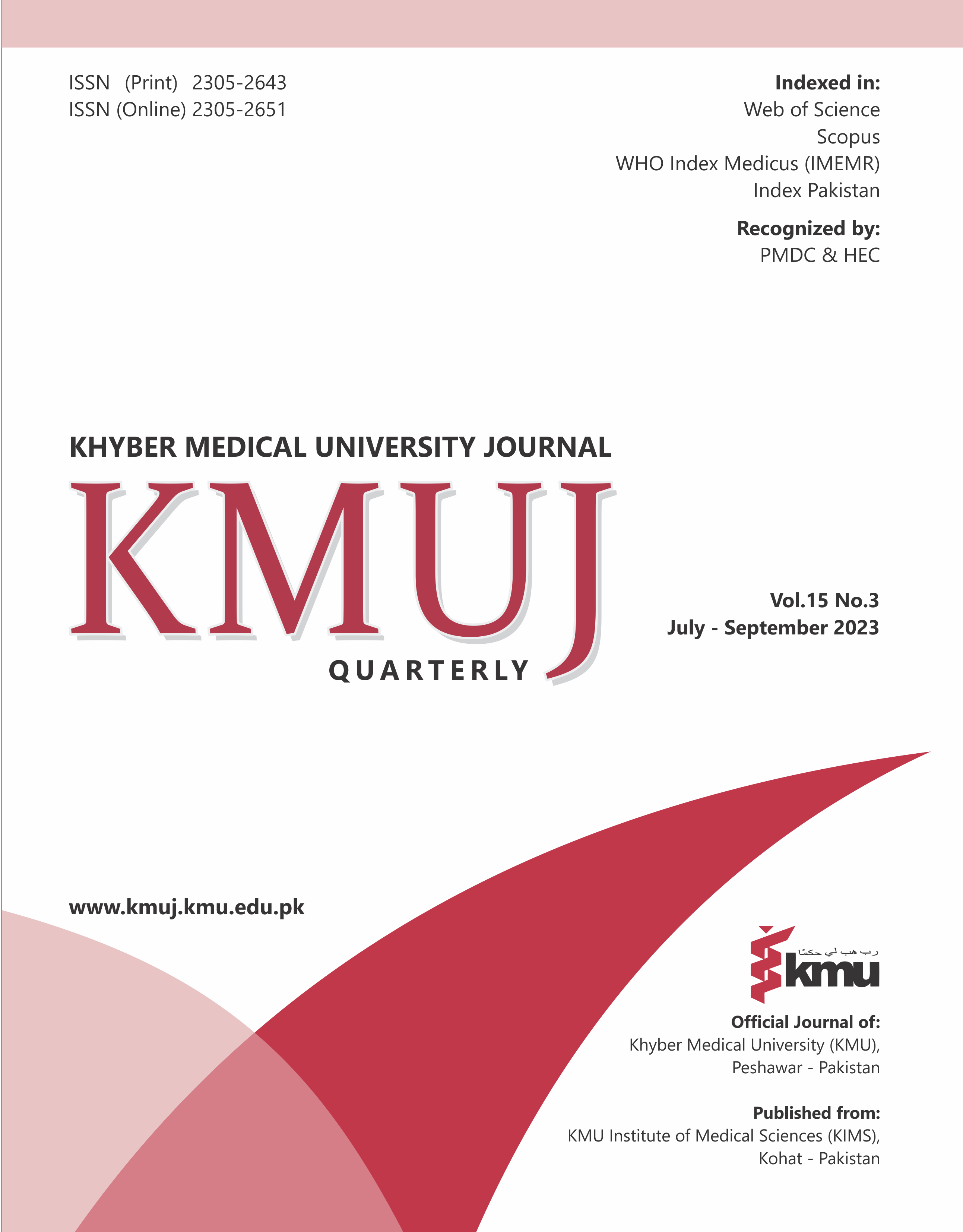Prevalence of methicillin resistant staphylococcus aureus in Rashid hospital, Dubai, United Arab Emirates
Main Article Content
Abstract
OBJECTIVES: To evaluate the prevalence of Methicillin-resistant Staphylococcus aureus (MRSA) and its antibiotic susceptibility at Rashid hospital in Dubai, United Arab Emirates (U.A.E).
METHODS: This retrospective cohort study was conducted among patients at Rashid hospital in Dubai, U.A.E. from January-December 2021. Isolates were put in blood and McConckey agars and gram- positive cocci in clusters were identified then incubated in a highly automated system called VITEK®2 to identify Staphylococcus aureus and its antibiotic susceptibility.
RESULTS: Out of 665 samples of S. aureus isolates, MRSA were 236 (35.5%) while 429 (64.5%) were Methicillin Sensitive Staphylococcus Aureus (MSSA). Among male patients, the highest frequency MSSA & MRSA isolation was observed in the age bracket of 40-49 years (n=64/285; 22.4%) and 50-59 years (n=31/160; 19.4%) respectively. Smilarly, in females the highest frequency MSSA & MRSA isolation was observed in the age range of 20-29 years (n=24/144; 16.7%) and 60-69 years (n=13/76; 17.1%) respectively. MSSA was most commonly isolated from 269 (62.7%) wound sites. The MRSA demonstrated resistance to most of the antibiotics with highest resistance towards Ciprofloxacin 103 (44%) and Fusidic acid 100 (42%). Among different antibiotics, the isolates remained highly susceptible to linezolid, tigecycline, teicoplanin, rifampicin and vancomycin.
CONCLUSION: the retrospective study at Rashid Hospital in Dubai identified a notable prevalence of MRSA (35.5%) and MSSA (64.5%), predominant in male patients. Age-specific patterns revealed higher frequencies of MSSA and MRSA isolations in distinct age brackets. MRSA displayed resistance to several antibiotics, emphasizing the need for judicious antimicrobial management in this healthcare setting.
Article Details
Work published in KMUJ is licensed under a
Creative Commons Attribution 4.0 License
Authors are permitted and encouraged to post their work online (e.g., in institutional repositories or on their website) prior to and during the submission process, as it can lead to productive exchanges, as well as earlier and greater citation of published work.
(e.g., in institutional repositories or on their website) prior to and during the submission process, as it can lead to productive exchanges, as well as earlier and greater citation of published work.
Funding data
-
University of Sharjah
Grant numbers 2001090177
References
Hassoun A, Linden PK, Friedman B. Incidence, prevalence, and management of MRSA bacteremia across patient populations-a review of recent developments in MRSA management and treatment. Crit Care 2017;21(1):211. https://doi.org/10.1186/s13054-017-1801-3
Dulon M, Haamann F, Peters C, Schablon A, Nienhaus A. MRSA prevalence in European healthcare settings: a review. BMC Infect Dis 2011;11:138. https://doi.org/10.1186/1471-2334-11-138
Pannewick B, Baier C, Schwab F, Vonberg R-P. Infection control measures in nosocomial MRSA outbreaks—Results of a systematic analysis. PLOS ONE 2021;16(4):e0249837. https://doi.org/10.1371/journal.pone.0249837
Boucher HW, Corey GR. Epidemiology of Methicillin-Resistant Staphylococcus aureus. Clinical Infectious Diseases 2008;46(Supplement_5):S344-S9. https://doi.org/10.1086/533590
Raut S, Bajracharya K, Adhikari J, Pant SS, Adhikari B. Prevalence of methicillin resistant Staphylococcus aureus in Lumbini Medical College and Teaching Hospital, Palpa, Western Nepal. BMC Res Notes 2017;10(1):187. https://doi.org/10.1186/s13104-017-2515-y
Turner NA, Sharma-Kuinkel BK, Maskarinec SA, Eichenberger EM, Shah PP, Carugati M, et al. Methicillin-resistant Staphylococcus aureus: an overview of basic and clinical research. Nat Rev Microbiol 2019;17(4):203-18. https://doi.org/10.1038/s41579-018-0147-4
Jaradat ZW, Hamdan TA, Hayajneh W, Al Mousa W, Al Shehabi A. Antibiograms, toxin profiling and molecular typing of Staphylococcus aureus isolates from two tertiary hospitals in Jordan. J Infect Dev Ctries 2017;11(11):876-86. https://doi.org/10.3855/jidc.8270
Alfeky AE, Tawfick MM, Ashour MS, El-Moghazy AA. High Prevalence of Multi-drug Resistant Methicillin-Resistant Staphylococcus aureus in Tertiary Egyptian Hospitals. J Infect Dev Ctries 2022;16(5):795-806. https://doi.org/10.3855/jidc.15833
Liang Y, Tu C, Tan C, El-Sayed Ahmed MAE, Dai M, Xia Y, et al. Antimicrobial resistance, virulence genes profiling and molecular relatedness of methicillin-resistant Staphylococcus aureus strains isolated from hospitalized patients in Guangdong Province, China. Infect Drug Resist 2019;12:447-59. https://doi.org/10.2147/IDR.S192611
Pai V, Rao VI, Rao SP. Prevalence and Antimicrobial Susceptibility Pattern of Methicillin-resistant Staphylococcus Aureus [MRSA] Isolates at a Tertiary Care Hospital in Mangalore, South India. J Lab Physicians 2010;2(2):82-4. https://doi.org/10.4103/0974-2727.72155
Waitayangkoon P, Thongkam A, Benjamungkalarak T, Rachayon M, Thongthaisin A, Chatsuwan T, et al. Hospital epidemiology and antimicrobial susceptibility of isolated methicillin-resistant Staphylococcus aureus: a one-year retrospective study at a tertiary care center in Thailand. Pathog Glob Health 2020;114(4):212-7. https://doi.org/10.1080/20477724.2020.1755550
